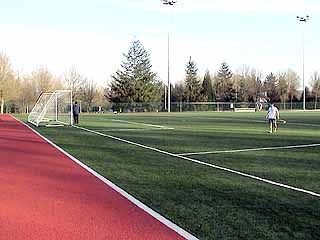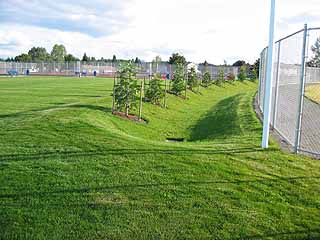
Surveys
DJC.COM
April 27, 2006
Site constrained? That's opportunity knocking
Bruce Dees & Associates

Photos courtesy Bruce Dees & Associates
Synthetic turf sports fields and a jogging track, all with porous surfaces, were used at Grass Lawn Park in Redmond to control storm water runoff.
|
It's a common scenario: The public demands space for recreation but the available land is beset with environmental constraints such as wetlands, critical habitat or groundwater protection. These challenges, however, provide opportunities for innovative design solutions and creative partnerships to provide recreation and open space while improving environmental quality.
Environmental constraints
Perrigo Park in Redmond is a prime example of the value of this process. Virtually surrounded by wetlands, the challenge for the design team was to construct two softball fields and two soccer fields on a site severely constrained by wetland setbacks, wetland buffer-mitigation requirements and groundwater protection. Adding to the list of issues facing the design team was the need to provide active open space that could be used in any weather.
The solution used synthetic turf with overlapping sports fields to allow the fields to be used continuously throughout the year without the need to "rest" them as would be the case with natural turf.
Considerable testing was conducted to assure there would be no detrimental effects from water passing through the synthetic turf material to the wetlands. The crushed rock base of the synthetic turf serves as a giant water reservoir, containing then slowly metering water into the wetlands, sustaining the wetlands, and enhancing water quality. Surface runoff from the tennis courts and parking lot is treated through a bioswale and then returned to supplement the wetland.
Perrigo Park provides a blend of environmental protection and enhancement with maximized recreation opportunities. This is a vast improvement over the original horse farm and its attendant nutrient runoff.
Grass Lawn Park
Another example is the recent renovation of Grass Lawn Park in Redmond. Originally constructed in the late 1970s, it is the city's most used year-round park, providing a variety of recreation opportunities while also serving as a unique respite in the city center.

Rainier Vista Community Park in Lacey serves as a regional storm water control facility, with infiltration pipes under the soccer fields and overflow areas on the perimeter of the softball/baseball complex.
|
After years of heavy use, most of Grass Lawn Park's sports fields and facilities had deteriorated to the point where both aesthetics and usability had declined. Many of the park elements, such as the original soccer field that was constructed with a mix of sand and crumb rubber, were contributing to excessive runoff that clogged the storm sewer system with silt and debris.
Renovations included new synthetic turf softball and soccer fields, the latter with a 10-foot-wide synthetic jogging track at the perimeter constructed with a porous base that eliminates surface runoff.
Today, there is no silt or nutrient runoff and subsequent tests have proven that there are no harmful materials contained in the water, which percolates through the field and into the subdrainage system.
The improvements to the soccer field doubled the available playing time, reduced maintenance costs, and improved the overall park aesthetics. Just as important was a dramatic improvement to water quality entering the storm sewer and eventual outfall to the salmon-supporting Sammamish River.
Public-private partnerships
Fort Dent is a 50-acre regional park also constructed in the early 1970s. The original master plan was never fully implemented and large portions of the park were left undeveloped. In recent years, the city of Tukwila, which managed the park, entered into a partnership with Starfire Sports, a nonprofit organization. This partnership, based upon a lease agreement to develop major undeveloped portions of the park, benefited both the city and the general public through the construction of soccer fields and other associated improvements.
In addition to issues related to construction adjacent to the Green River, environmental constraints such as storm water runoff, siltation, areas possibly containing American Indian artifacts, and protection of existing trees and vegetation, influenced the design.
The resulting improvements of four full-sized synthetic turf soccer fields, each sited to preserve the park's original mature trees, allows maximum use of the site while drastically improving the quality of storm water runoff. The Green River is no longer affected by silt or nutrient runoff from the fields.
This public-private partnership improved the environmental health of the river and used undeveloped park space to create much-needed recreation facilities for the entire region.
Interagency partnerships
Prior to construction of Rainier Vista Park, the city of Lacey needed to address storm water containment in the area and provide recreation opportunities for the growing number of residents. The 46-acre acquisition was accomplished by combining parks and public works funds to achieve a long-range goal of providing both a high-quality community park and an emergency storm water facility.
Closely coordinating with Lacey Public Works and Parks Department, the design team designed the park to be constructed in two phases. Initial development occurred by partnering with the U.S. Army Corps of Engineers to rough grade the entire site and install storm water galleries for emergency storm containment under what would later become soccer fields.
Rainier Vista Community Park does not look like it is a regional storm water control facility, but while the surface accommodates recreational activities, below the ground the site can accept 2 million cubic feet of storm water in a 24-hour period from the surrounding area, protecting the community from flooding. Storm water enters the northwest corner of the site then is directed into the gallery of infiltration pipes under three soccer fields. Surface runoff from parking lots is collected, treated and then directed to the infiltration galleries under the soccer fields as well.
In the event storm water galleries fill, overflow follows the perimeter of the softball/baseball complex and enters additional infiltration structures. In an extreme storm event where infiltration capacity is reached, water is conveyed to yet another storage pond that also serves as an aesthetic feature of the park.
Through innovative design and creative partnerships, environmental constraints can be opportunities for environmental improvement while providing recreation space for the public.
Bruce Dees, FASLA, is a landscape architect with Bruce Dees & Associates.
Other Stories:
- Arsenic-eating ferns may clean up Puget Sound soils
- Is this as green as Seattle gets?
- Putting a forest floor up on the roof at the zoo
- Program catalogs our fading historic landscapes
- Veterans' cemeteries: an inspiration of place
- Creating an urban forest in Anchorage
- Using GIS as a tool to protect Puget Sound
Copyright ©2009 Seattle Daily Journal and DJC.COM.
Comments? Questions? Contact us.